| Author |
Message |
Ken Bolton

|
 Posted: Tue 31 Aug, 2004 2:47 pm Post subject: Pictish Weapons? Posted: Tue 31 Aug, 2004 2:47 pm Post subject: Pictish Weapons? |
 |
|
|
Im just curious if anyone has any links or knows of any examples of weapons made by the Picts. Ive heard of a few people trying to make a few replica Pictish swords but most of these are still in production. Anyways Id be gratefull for any information.
|
|
  |
 |
Wes Jackson

Location: Houston Joined: 29 Jul 2004
Posts: 19
|
 Posted: Tue 31 Aug, 2004 8:00 pm Post subject: Posted: Tue 31 Aug, 2004 8:00 pm Post subject: |
 |
|
Ken, from what I have been reading over the past week, there are little to no examples of Pictish weapons. According to Julian Richards in the book "Blood of the Vikings" he visited the Norse settlement that was excavated at Buckquoy in Orkney. They found some pottery and combs etc.. that had Pictish origins but no weapons. Here is a quote from the book
| Quote: | | It may be some time before we can say for sure just why the Pictish culture seems to have vanished after the Vikings arrived on the Northern Isles. |
Sorry, not much help but I wanted to pass on the info I had...
Wes
|
|
  |
 |
|
Eric Wargo
Location: Alexandria, VA Joined: 31 Aug 2004
Posts: 14
|
 Posted: Tue 31 Aug, 2004 8:27 pm Post subject: Pictish Weapons? Posted: Tue 31 Aug, 2004 8:27 pm Post subject: Pictish Weapons? |
 |
|
I'm interested in this too. As far as I know there are very few known examples of Pictish weapons (besides what is depicted in their art). But a useful resource for you would be the book Pictish Warrior AD 297-841 by Paul Wagner (published by Osprey, in their Warrior series). It includes a reconstruction of a possible 10th-century Pictish sword in the National Museum of Scotland and drawings of a few other possible Pictish sword-fragments, including the drawing (on p. 43) of the bizarre sword that was supposedly part of the Norries Law Horde discovered (and then subsequently melted down) in the 19th century. (The sword has a circular guard backed by a long quillon and a tiny spherical pommel; the drawing was made from memory, however, and has been dismissed as fantastical.)
The new book The Art of the Picts (by George and Isabel Henderson, published by Thames and Hudson) also has a nice drawing of a beautiful silver sword pommel and two scabbard chapes found as part of a horde on St. Ninian's Isle, Shetland. They are so similar to Anglo-Saxon designs that they might be of Anglo-Saxon make, however.
I could scan these pics for you if you are interested.
Eric
|
|
   |
 |
Ken Bolton

|
 Posted: Wed 01 Sep, 2004 10:02 am Post subject: Posted: Wed 01 Sep, 2004 10:02 am Post subject: |
 |
|
| Quote: | | I could scan these pics for you if you are interested |
Go right ahead, Id love to see any pictures you may have.
What Im trying to figure out is how come a culture that managed to defeat some of the Roman Empire's strongest forces just vanished seemingly without a trace. Unless they just mixed with the Anglo, Norman, and other Celtic cultures of Briton which is probably what happened, but its still very bizarre that they would leave no cultural identity behind.
|
|
  |
 |
Robert W. Betten

|
 Posted: Wed 01 Sep, 2004 10:26 am Post subject: Posted: Wed 01 Sep, 2004 10:26 am Post subject: |
 |
|
I'm interested in the culture, but one thing about history is it has the ability to make entire civilisations fall into myth withing a few thousand years of their existence (Friday Island civilisation for example)...I'd love to see any possible reminants of Pictish weapons, even carvings or other evidence that may give good pointers as per what they would have carried, if they had religious significant icons on the hilt (ie. Norse tri-lobe representing the valknot, even if thats kind of speculated).
History surely is a funny and interesting thing...
*!*
"If the people we love are taken from us,
the way they live on is to never stop loving
them. Buildings burn, people die, but real
love is forever." - Sarah 'The Crow'
|
|
       |
 |
Ken Bolton

|
 Posted: Wed 01 Sep, 2004 11:21 am Post subject: Posted: Wed 01 Sep, 2004 11:21 am Post subject: |
 |
|

Here is one of the few images I found searching, they appear to be elaborate crossguards. Id imagine the blade would have been similair to those of the Celts.
|
|
  |
 |
|
Eric Wargo
Location: Alexandria, VA Joined: 31 Aug 2004
Posts: 14
|
 Posted: Wed 01 Sep, 2004 11:56 am Post subject: Posted: Wed 01 Sep, 2004 11:56 am Post subject: |
 |
|
Ken,
Those are the objects described in The Art of the Picts as scabbard chapes (and incorporated as such in the reconstruction paintings in Pictish Warrior). I don't have the books here at my office--I'll scan the pictures tonight and post them.
The best general book on the Picts and their history is The Age of the Picts by W.A. Cummins (1995)--It is very readable, comprehensive, inexpensive, and above all, short. (That's the great advantage of studying a culture about which almost nothing is known!) I think Cummins argues pretty much what you said--that they didn't disappear but just blended with the Scots (i.e. Irish) of Dalriada. He does a great job of reconciling the various chronicles, king-lists, and other patchy historical sources and giving a pretty coherent picture of Pictish history and politics from the fifth through ninth centuries, and why they were so successful (for a while) at keeping out their enemies. Particularly interesting is the chapter on Pictish relations to Northumbria. He also has an interesting hypothesis about the meaning of Pictish symbol stones and good discussions of Pictish language, place-names, matrilinearity, etc. I highly recommend this book.
As far as leaving cultural identity behind, they did leave lots of art, which, while hard to interpret, is pretty astonishing. (And it does show a lot of weapons, although obviously not in sufficient detail to be much use in reconstructing their unique style.)
Eric
|
|
   |
 |
Sean Flynt

|
|
   |
 |
|
Nathan Bell
|
 Posted: Wed 01 Sep, 2004 5:50 pm Post subject: Posted: Wed 01 Sep, 2004 5:50 pm Post subject: |
 |
|
Which time period of Pictish weaponry are you thinking of?
I found the Pictish warrior Osprey book to have a decent idea or two with regards to the early period swords, but also perhaps took certain aspects too far
For instance, they speculate that the Picts may have been equipped with La Tene IV swords, based upon North British finds. When they show the warrior in the plate, however, he is carrying a sword which resembles a British find but appears to be too long in the blade---most of the British late La Tene finds are significantly smaller than their Continental counterparts---for instance, the Embleton sword has a blade only about 21 1/2".
Similarly, they depict swords based upon Irish Iron Age swords and hilts. This seems plausible, given that there have been pommel and cross guard finds very similar to the Irish Iron age swords found in Scotland. However, they draw these Irish/Pictish swords based on what I believe to be a bad reconstruction of the Irish Lisnacrogher sword. Second, they again make these sowrds far too long. The Picts in the plates, by looking at body proportion and comparison to their foes' weapons, appear to be weilding swords with blades 20 + inches in length. Whereas, the Irish swords are all quite small, usually right around 16" blade or so, the largest being about 19" and many being smaller than 16".
The shield reconstructions and spearhead line drawings seem to match up nicely with possible weapons, though, and the attention to the characteristically British Isles Knobbed-butt spears is nice.
I attach a picture of a reconstruction of an Irish Iron Age sword that I own, quite plausibly very similar to swords in use in North Scotland in the early century or two AD...
 Attachment: 32.41 KB Attachment: 32.41 KB
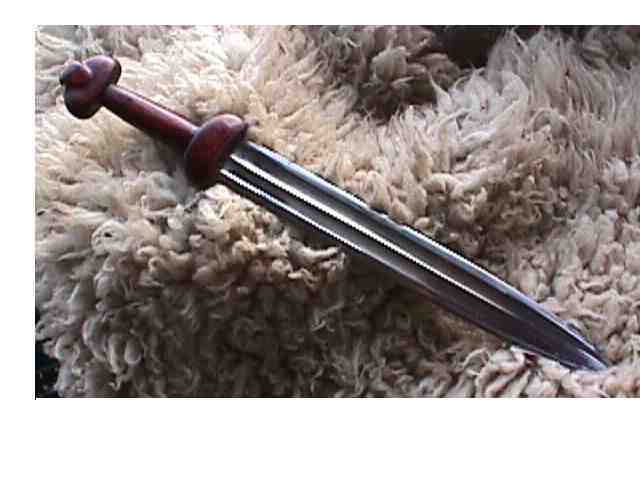
|
|
   |
 |
|
Eric Wargo
Location: Alexandria, VA Joined: 31 Aug 2004
Posts: 14
|
 Posted: Wed 01 Sep, 2004 6:39 pm Post subject: Posted: Wed 01 Sep, 2004 6:39 pm Post subject: |
 |
|
Here is the possibly Pictish (but possibly Anglo-Saxon) silver-gilt sword pommel found in Shetland (from Henderson et al, The Art of the Picts [Thames & Hudson, 2004], pp 114 and 113.
 Attachment: 124.79 KB Attachment: 124.79 KB
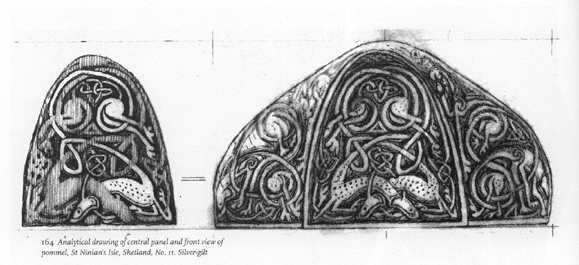
|
|
   |
 |
|
Eric Wargo
Location: Alexandria, VA Joined: 31 Aug 2004
Posts: 14
|
 Posted: Wed 01 Sep, 2004 6:56 pm Post subject: Posted: Wed 01 Sep, 2004 6:56 pm Post subject: |
 |
|
These illustrations are from Wagner, Pictish Warrior, illus. by Wayne Reynolds (Osprey, 2002), pp. 43, 37, 23:
1) the bizarre Norrie's Law sword drawn from somebody's memory after the thing was melted down; 2) reconstruction of a sword based on (I think) "f" in (3) below + a scabbard incorporating chapes discovered at Shetland; and 3) drawings of Pictish sword finds.
Hope this helps.
Eric
 Attachment: 44.68 KB Attachment: 44.68 KB
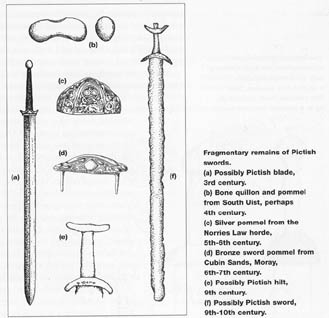
 Attachment: 24.65 KB Attachment: 24.65 KB
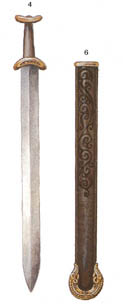
 Attachment: 26.9 KB Attachment: 26.9 KB
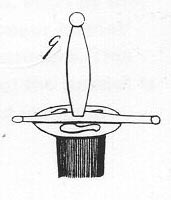
|
|
   |
 |
|
Eric Wargo
Location: Alexandria, VA Joined: 31 Aug 2004
Posts: 14
|
 Posted: Wed 01 Sep, 2004 6:58 pm Post subject: Posted: Wed 01 Sep, 2004 6:58 pm Post subject: |
 |
|
|
Actually those pictures are in reverse order from what I wrote.
|
|
   |
 |
|
Allen W
|
 Posted: Thu 02 Sep, 2004 7:43 am Post subject: Posted: Thu 02 Sep, 2004 7:43 am Post subject: |
 |
|
I have to second the recommendation for Cummins. This is an excellent work. As to the disappearance of the Picts he credits a royal mariage between the matrilineal inheriting Picts and the patrilineal inheriting Dal Riadan Scots in an alliance against the Vikings and Northumbrians. Kenneth MacAlpine was then heir to both lines and is traditionally recorded as the first King of Scotland. Thereafter patrilineal succession was the norm though Dal Riadan, Pictish, and subsequent Scottish succession allowed for election from among the dead king's brothers or offspring.
The pommel from the St.Ninian's hord looked more like a small, semi-pyramidal pommel "cap" very much like that on the Sutton Hoo sword (I type this from memory-it being years since I last saw a photo of it). I also remember the sword fragments (I forget which hord the were found in) as looking like the point of a very narrow spatha or Maekir.
In general the Picts seem to have used the same weapons as their neighbors, though they may have had their own decorative motifs. The use of bucklers at this time is exceptional as is the square form.
|
|
  |
 |
|
Eric Wargo
Location: Alexandria, VA Joined: 31 Aug 2004
Posts: 14
|
 Posted: Thu 02 Sep, 2004 10:48 am Post subject: Posted: Thu 02 Sep, 2004 10:48 am Post subject: |
 |
|
|
Incidentally there is an informative thread on this topic on Sword Forum International from about a year ago; search for "Pict Swords" in the Ancient Weapons Forum.
|
|
   |
 |
Ken Bolton

|
 Posted: Thu 02 Sep, 2004 1:50 pm Post subject: Posted: Thu 02 Sep, 2004 1:50 pm Post subject: |
 |
|
| Quote: | | In general the Picts seem to have used the same weapons as their neighbors, though they may have had their own decorative motifs. |
It doesn't surprise me that the few examples remind me of similar Celtic style's, even much of the Pictish art work is reminiscent with some variations. That's probably why some historians believe the Picts may have migrated from Ireland and settled in the area of what is now Scotland.
Thanks to all of you for the information.
|
|
  |
 |
|
|

